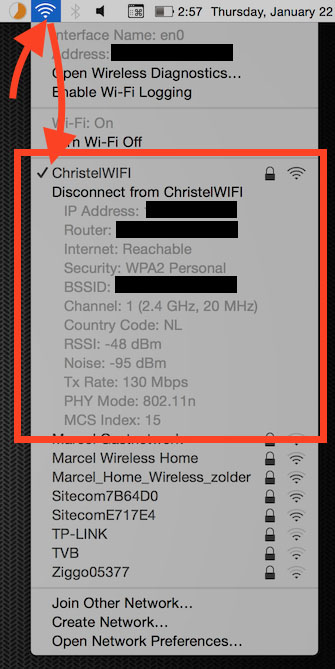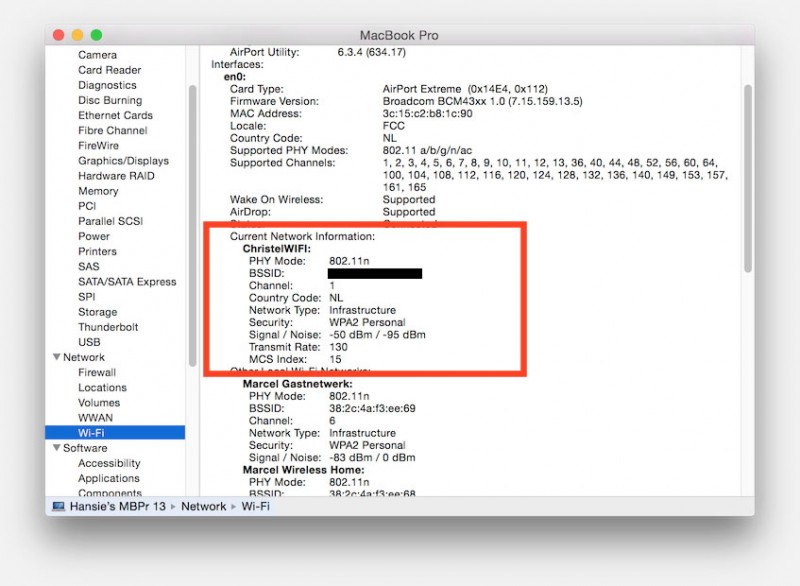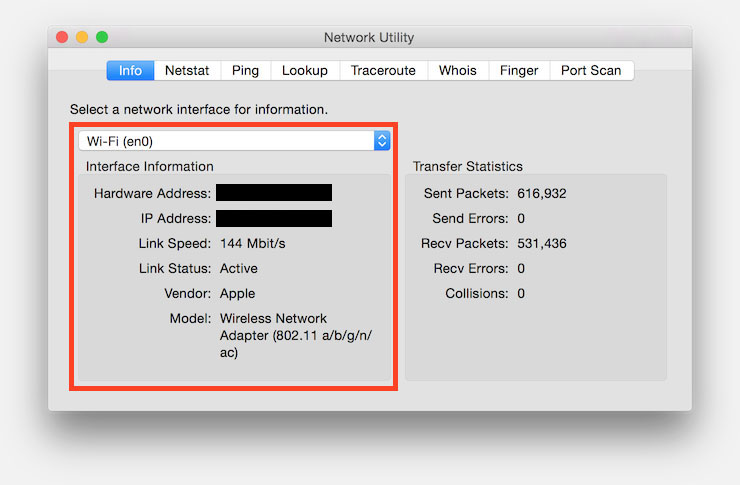While working on my DD-WRT project for my NetGear R7000 router, I ran some tests to see what the ideal connection setup for my router would be.
During the testing you’d typically want to see the speed of your WiFi connection, possibly including noise, RSSI, channel, country code, used frequency, etc. and initially it can be a bit daunting where to find this information. But … surprise: this info is readily available on your Mac, no extra software is needed, you just need to know where it’s hidden …
Therefor in this article 4 methods to figure this out on your Mac, without the need to install specific software for the task.
Determining WiFi speed on your Mac
Below I’ll show you 4 methods to determine some of the characteristics of your current WiFi connection.
For this we will use build-in tools that come with your MacOS X.
I highly recommend the first method, since it’s easy to access, fast and provides a lot of good information.
Ad Blocking Detected Please consider disabling your ad blocker for our website.
We rely on these ads to be able to run our website.
You can of course support us in other ways (see Support Us on the left).
To examine the speed of your WiFi connection, you can use the WiFi icon in the menu bar of your Mac.
Simply clicking it though will not provide you this information. You’ll have the press the OPTION (or ALT) key and keep it pressed while clicking the WiFi icon.
When you do so, a list will be presented with additional data:
- WiFi network name (SSID)
- IP Address of your computer
- IP Address of the router or modem
- If Internet is reachable
- What type of security is used
- BSSID
- Channel
- Country Code (each country has it’s own set of regulations)
- RSSI (Received signal strength indication)
- Noise (signal disruption)
- TX Rate (tansmission speed)
- PHY Mode (Radio mode)
- MCS Index (index number for modulation and coding the signal)

MacOS X – WiFi info with ALT+Click on WiFi icon
This method is a little bit more limited, yet provides good info.
Go to the icon in the upper left corner of your screen, select “About this Mac” “System Report…“.
(you can find this also through Spotlight by typing “System Information”)

MacOS X – Wifi info in the System Report
Ad Blocking Detected Please consider disabling your ad blocker for our website.
We rely on these ads to be able to run our website.
You can of course support us in other ways (see Support Us on the left).
Method 3: Network Utility
Network Utility is a little harder, as it seems to have the habit of changing location with each MacOS X version.
The easiest way to find Network Utility is through Spotlight.
Open Spotlight, type “Network Utility“, and press ENTER.
Select under the “Info” tab, select your WiFi device from the dropdown list, and you’ll see your speed under “Link Speed“.
Note: Sometimes Network Utility does not show your WiFi connection. Close the application and try again.

MacOS X – WiFi Speed through Network Utility
Method 4: Terminal (Command Line)
This is more for those folks that prefer the Terminal, and honestly, it took me a while to find this one.
Open a Terminal (Applications Utilities Terminal) and type:
/System/Library/PrivateFrameworks/Apple80211.framework/Versions/Current/Resources/airport -I
The output should show something like this, where you see “lastTXRate” and “maxRate” indicating speed values for your WiFi.
1
2
3
4
5
6
7
8
9
10
11
12
13
14
15
16
| /System/Library/PrivateFrameworks/Apple80211.framework/Versions/Current/Resources/airport -I
agrCtlRSSI: -49
agrExtRSSI: 0
agrCtlNoise: -95
agrExtNoise: 0
state: running
op mode: station
lastTxRate: 130
maxRate: 144
lastAssocStatus: 0
802.11 auth: open
link auth: wpa2-psk
BSSID: 2c:85:7e:4a:b3:ca
SSID: ChristelWIFI
MCS: 15
channel: 1 |
In Terminal you could create a shortcut for this, and this can be done in 2 ways.
One is creating and alias (recommended), and the other by creating a symbolic link.
Either solution allows you to simply type “airport” on Terminal without having to type the full path.
The creation of an alias is recommended, and can be done like so (thanks Greg for the excellent suggestion!):
alias airport='/System/Library/PrivateFrameworks/Apple80211.framework/Versions/Current/Resources/airport'
Or if you prefer a symbolic link:
1
2
| cd /usr/sbin
sudo ln -s /System/Library/PrivateFrameworks/Apple80211.framework/Versions/Current/Resources/airport |




Comments
There are 16 comments. You can read them below.
You can post your own comments by using the form below, or reply to existing comments by using the "Reply" button.
thank youu! terminal command was the best way i think.
aldwada
I agree,… I use method 1 for a quick look, and command line for a more accurate way of looking at things.
hans
How can I get this extra information about my wifi connection on Windows OS?
noname
Not sure which Windows version you’re running, and what info specifically you’re looking for.
Under Windows 10 (I believe this works under Windows 7 and up, but I could only test Windows 10), you could try the following in a DOS box:
You could also consider something like WiFi Analyzer (free), or NirSoft WiFiInfoView (I believe that’s free as well).
hans
This is helpful. Thank you.
I just bought a 2018 MacBook Pro 15 and I’ve been trying to find my WiFi connection speed. As you point out, just clicking the network icon in the menu bar doesn’t provide that information. You have to hold the option key.
My first thought was to look in Network Utility, but on the 2018 computers this doesn’t work. It shows 54 Mbps, no matter what network you’re connected to. I’ve confirmed this with other 2018 Macs in BestBuy and the Apple store. I did eventually stumble upon the System Report method. But the option-click on the network icon is by far the best. Thank you.
I’ve contacted Apple support on the Network Utility problem. So far, their explanation is that the network adapter is “too advanced” for the router, and because this information comes from the router and not the adapter, Network Utility cannot display it. That seems wrong to me. The computer has the information, which can be obtained in the three other ways described. The problem is either with the driver for the network adapter or with Network Utility. I’ll keep after them on this and we’ll see if they eventually acknowledge the problem. See https://discussions.apple.com/thread/250079088
Leonard Flier
Hi Leonard!
Good to hear the info is useful.
I just checked the Network Utility on my Macbook (12″ – 2017) and it shows a 144Mbit/s speed. I’ll have to give this a try on my 2017 MacBook Pro later today … I agree that the statement that “this info comes from the router” seems wrong. However, the combination of router and MacBook WiFi determine the maximum achievable speed. Not sure how old your router is.
Personally I love WiFi Explorer – the Lite version is Free.
The “Standard” version is $19 at this time (Apple Store). Both seem to be very helpful – give it a try. It gives very good info about all WiFi access points near you – it has been very helpful for me to determine the most ideal channels for my Access Points.
I Highly recommend this tool – I’m pretty sure I didn’t pay $19, so I probably have the FREE Lite version, which works great
hans
Oh just found the Lite version in the Apple Store, and can see that I may have the standard version after all.
Just give the lite version a try for starters … worth it!
hans
Another good tip. WiFi Explorer Lite is a great app. Now I can see the whole WiFi environment wherever I am. Many thanks!
Leonard Flier
Awesome Leonard! Glad to hear that worked out for you
hans
Hi,
I wonder if I can do the same to check network stuff on my iPhone that is connected to my laptop . such as the speed is it 4G or 3G is it connected to internet or not and etc .
Daad
Hi Daad,
With Mojave I can see what connection type my iPhone has (4G indicator anyway). But it’s much more limited than the WiFi info indeed.
A seemingly good app for your iPhone would be LTE Cell Info (not just LTE info) – but it’s not what you’re looking for since you wanted it on your laptop.
Maybe Bandwith+ is helpful? Haven’t tested it.
hans
thank you so much
I just forgot to say that I wanna do this through command line or the terminal, is there any way ?
thanks again
Daad
I am not aware of a tool for Terminal that could do this – sorry
 .
.
I don’t think these details are “known” since your iPhone connects over WiFi – but your Mac doesn’t know about of the 3G/4G connection behind the WiFi. But I could be wrong of course
hans
Once you re there, you can see the current connection speed by looking at the Link Speed, which will show the actual data rate that you re using. This rate will change as you move around your house, so if you re far away from the router, the rate will change, and if you re closer, it will get higher.
Gregersenartpoint
Don’t bother creating a symlink, simply create an alias in your ~/.bash_profile:
Then open a new terminal window.
Greg
Thanks Greg!
Excellent suggestion for Terminal users, and probably a better one at it – I’ll add it to the article
Hans